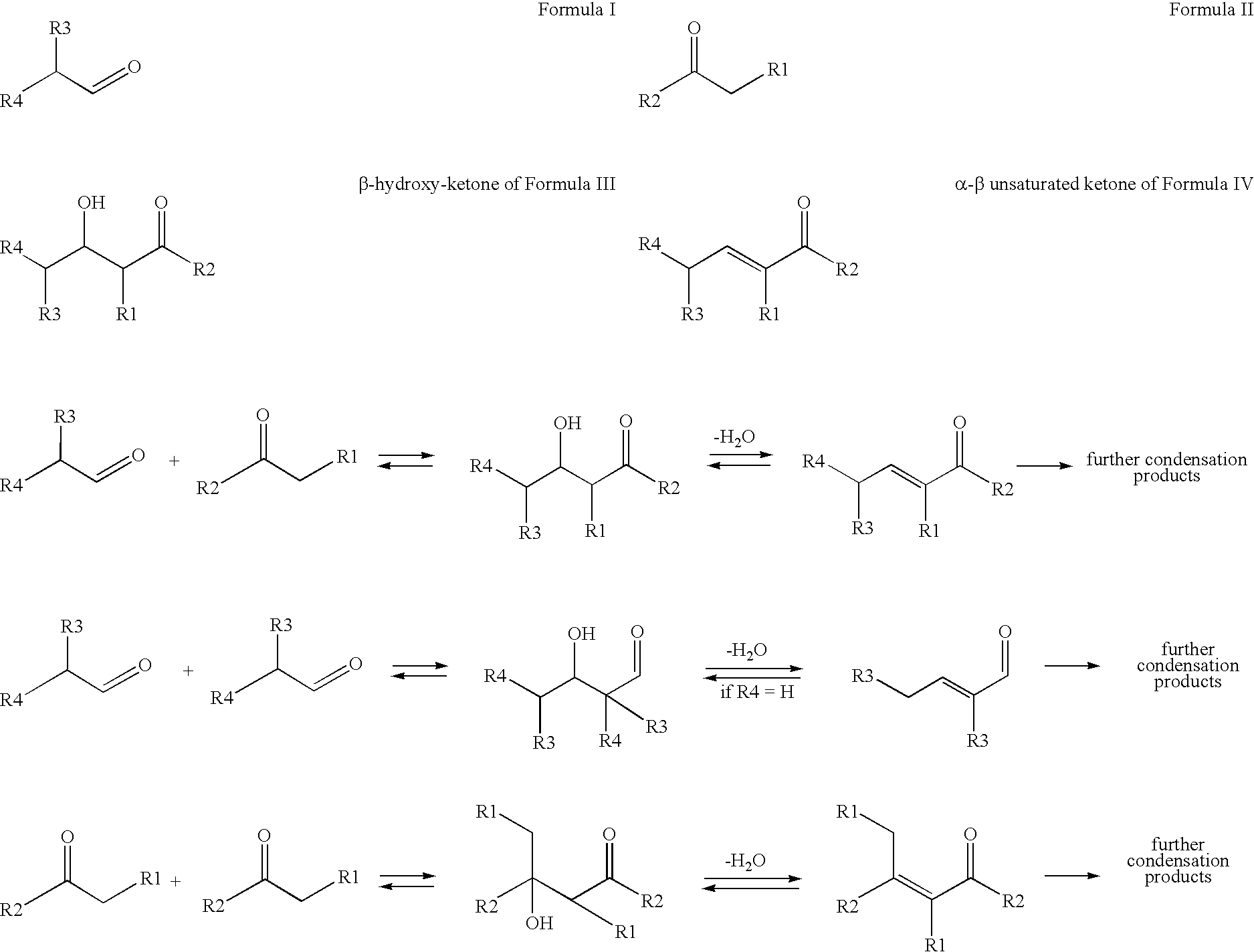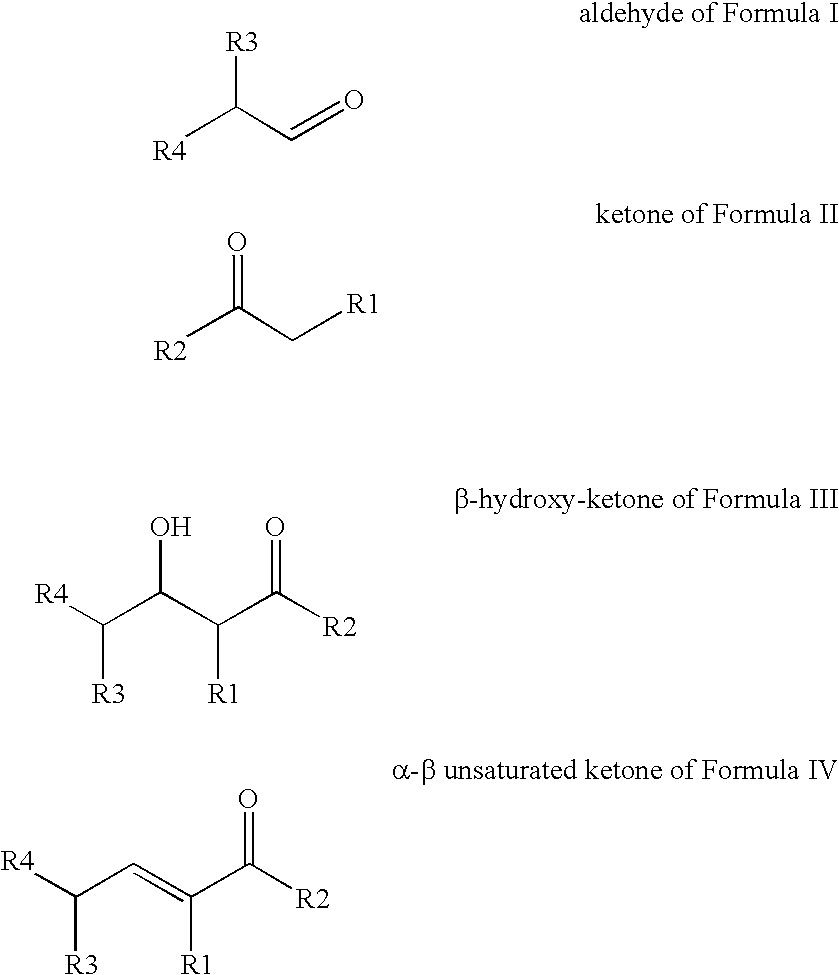Processes for preparing beta-hydroxy-ketones and alpha,beta-unsaturated ketones
a technology of beta-hydroxy-ketones and alpha, which is applied in the field of ketone chemistry, can solve the problems of reactive and susceptible, ketones and aldehydes, and rapid succession of condensation and subsequent dehydration reactions, and achieve the effect of reducing reaction times
- Summary
- Abstract
- Description
- Claims
- Application Information
AI Technical Summary
Benefits of technology
Problems solved by technology
Method used
Image
Examples
example 1
32.54 grams of acetone and 2.99 grams of n-butyraldehyde were charged to a 100 ml autoclave fitted with a magnetic stirrer, nitrogen purge, cooling coil, temperature-controlled band heater, and blow case for introduction of reactants and catalysts under pressure. The blow case was charged with 3.63 grams of acetone and 0.0717 grams of 50% aqueous sodium hydroxide solution and valved-off from the reactor vessel. These specifications gave a total feed of 13 moles of acetone per mole of n-butyraldehyde and 0.08 moles caustic per mole of n-butyraldehyde. The total amount of water present in the reaction mixture at the start of the reaction, based on the total weight of reactants, was thus about 0.38%. The autoclave was sealed, purged with nitrogen, and heated to 60° C., while stirring at 1800 rpm. Once a stable temperature had been reached the blow case was pressurized with nitrogen and the valve was opened to allow introduction of the blow case contents into the reaction vessel. The c...
example 2
36.65 grams of acetone and 1.39 grams of 50% aqueous sodium hydroxide solution were charged to a 100 ml autoclave fitted with a magnetic stirrer, nitrogen purge, cooling coil, temperature-controlled band heater, and blow case for introduction of reactants and catalysts under pressure. The blow case was charged with 3.40 grams of n-butyraldehyde and valved-off from the reactor vessel. These specifications gave a total feed of 13.4 moles of acetone per mole of n-butyraldehyde and 0.37 moles caustic per mole of n-butyraldehyde. The total amount of water present in the reaction mixture at the start of the reaction, based on the total weight of reactants, was thus about 1.7 wt. %. The autoclave was sealed, purged with nitrogen, and heated to 90° C., while stirring at 1800 rpm. Once a stable temperature had been reached the blow case was pressurized with nitrogen and the valve was opened to allow introduction of the blow case contents into the reaction vessel. The contents of the reactor...
examples 5-7 (
Inventive), and Examples 8-9 (Comparative)
A standard solution was prepared, consisting of 49.27 grams of acetone mixed with 15.51 grams of n-butyraldehyde. The molar ratio of acetone to butyraldehyde in the standard solution was 3.9. For Examples 5-7 and Counterexamples 7 and 8, the solution was then divided into approximately equal sized portions and poured into five 4-dram capped vials. A teflon-coated stir bar was used for agitation, and each vial was placed on a magnetic stirring plate. Solid sodium hydroxide pellets and solutions of 50%, 28%, 12.5%, and 5% aqueous sodium hydroxide were prepared and added at time zero to each of the five vials. The vials were sealed, stirred, and allowed to react initially at room temperature. The vials were sampled 22 minutes after introduction of the caustic catalyst. The samples were cooled to about 17° C. as collected and quenched by buffering to pH=7. All analyses were done by gas chromatography.
PUM
| Property | Measurement | Unit |
|---|---|---|
| temperature | aaaaa | aaaaa |
| temperature | aaaaa | aaaaa |
| temperature | aaaaa | aaaaa |
Abstract
Description
Claims
Application Information
 Login to View More
Login to View More - R&D
- Intellectual Property
- Life Sciences
- Materials
- Tech Scout
- Unparalleled Data Quality
- Higher Quality Content
- 60% Fewer Hallucinations
Browse by: Latest US Patents, China's latest patents, Technical Efficacy Thesaurus, Application Domain, Technology Topic, Popular Technical Reports.
© 2025 PatSnap. All rights reserved.Legal|Privacy policy|Modern Slavery Act Transparency Statement|Sitemap|About US| Contact US: help@patsnap.com



